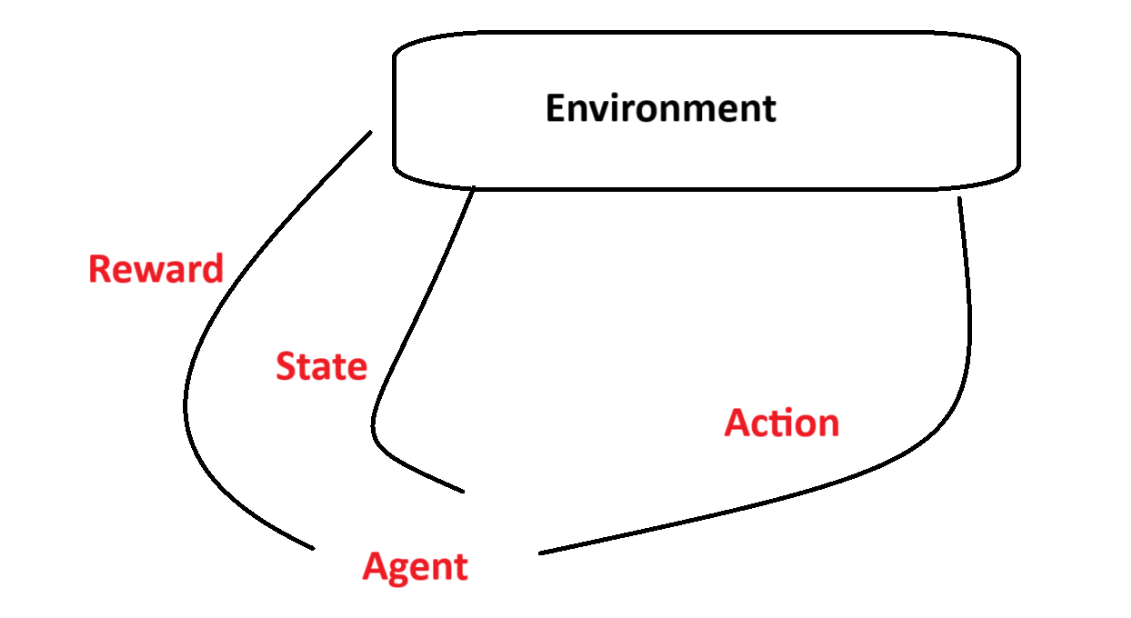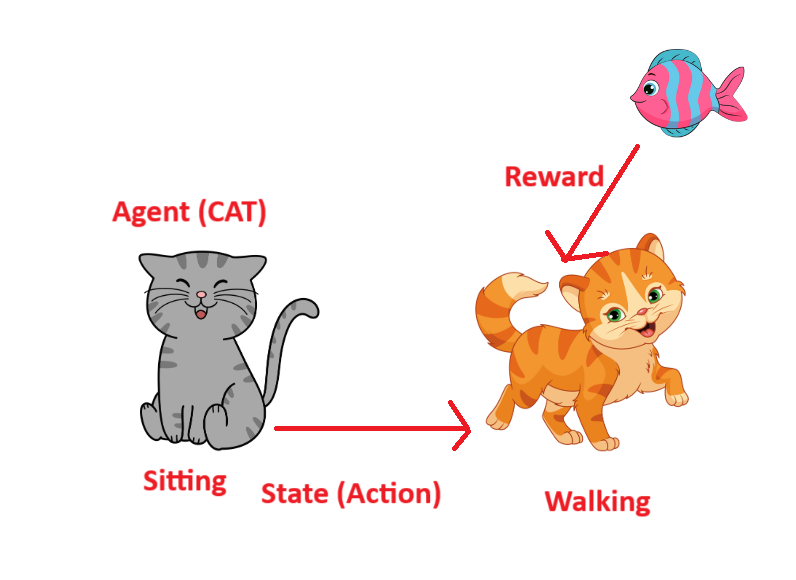Reinforcement Learning in machine learning is transforming how machines learn by mimicking human trial-and-error. Unlike traditional supervised learning, Reinforcement Learning in machine learning enables an agent to interact with its environment, receiving feedback through rewards or penalties to refine its strategies.
This dynamic, experience-driven approach powers innovations like self-driving cars, robotics, and advanced game-playing AI. In this blog, we will go through what makes RL a game changer in machine learning and explore its growing impact across industries.
What is Reinforcement Learning in Machine Learning?
Reinforcement Learning (RL) is a powerful subset of machine learning. It is used to solve interacting problems by determining which action to take at time t+1 using data collected up to that point. It is also used in artificial intelligence to teach machines to perform tasks like walking. Desired outcomes reward the AI, whereas undesirable outcomes punish it. Machines learn through trial and error.
Reinforcement learning in machine learning is a dynamic and fascinating branch of machine learning that mirrors the way humans and animals learn from their experiences. Imagine a curious child exploring their environment: every action, whether rewarded or penalized, shapes their future decisions. In reinforcement learning, this concept is brought to life through algorithms that enable machines to learn by interacting with an environment, making decisions, and improving their performance based on feedback.
The magic of reinforcement learning in machine learning lies in its trial-and-error approach. Instead of being explicitly programmed with every rule or strategy, the agent learns optimal behavior by continuously experimenting and refining its decisions. This adaptability makes reinforcement learning particularly powerful for solving complex problems where predefined instructions fall short.
Reinforcement learning In Machine Learning Examples:
- Gaming AI: Reinforcement learning has revolutionized video game strategies, enabling bots to outperform humans in games like Chess, Go, and even StarCraft.
- Robotics: Robots equipped with reinforcement learning learn tasks such as walking, picking objects, or navigating complex terrains by practicing in simulated environments.
- Self-Driving Cars: Reinforcement learning helps autonomous vehicles learn to make safe and efficient decisions in ever-changing road conditions.
Major Components of Reinforcement Learning

- Agent: The decision-maker that learns learns and acts.
- Environment: The external system with which the agent interacts.
- Actions: Choices available to the agent.
- Reward Signal: Feedback to the agent on the quality of its action
- Policy: The agent’s strategy for choosing actions.
- Value Functions: A prediction of future rewards to guide long-term decisions.
Why is Reinforcement Learning Transformative?
Reinforcement learning is more than just an algorithmic technique; it is a framework for innovation. Its ability to tackle real-world problems with no clear answers makes it indispensable in areas like personalized recommendations, finance, healthcare, and energy optimization. Moreover, reinforcement learning embodies the essence of human learning: adapting, evolving, and thriving through experience.
In a world that increasingly demands intelligent systems capable of autonomous decision-making, reinforcement learning is paving the way for smarter, more intuitive machines.
How does Reinforcement Learning Work?
Imagine a young puppy exploring a backyard for the first time. It sniffs around, encounters objects, and occasionally receives rewards for good behavior. Over time, the puppy learns which actions, like sitting on command or not chewing the garden hose, lead to positive outcomes. This natural trial-and-error process mirrors the core concept of reinforcement learning (RL) in artificial intelligence (AI).
Reinforcement learning is a powerful branch of machine learning where an agent learns by interacting with its environment. Unlike traditional machine learning methods that rely on static datasets, RL focuses on dynamic decision-making in real time.
Reinforcement learning unfolds in a loop:

- Observation: The agent perceives the state of the environment. For example, the puppy notices the smell of a flowerbed.
- Action: Based on its observations, the agent chooses an action. It could sniff the flowers or chase a butterfly.
- Reward: The environment provides feedback. If the action is favorable, like avoiding the hose, the puppy might earn a treat.
- Update: The agent adjusts its understanding of which actions lead to the best rewards, refining its policy (a strategy for choosing actions).
Over time, the agent strives to maximize cumulative rewards, the ultimate goal of reinforcement learning.
Algorithms That Drive Reinforcement Learning
Several algorithms drive the learning process:
- Q-Learning: A model-free method where the agent learns the value of actions in specific states, building a “cheat sheet” for optimal decision-making.
- Deep Reinforcement Learning (DRL): Combines reinforcement learning with deep learning, enabling agents to handle vast, complex environments like video games or robotics.
- Policy Gradient Methods: Directly optimize the agent’s policy instead of learning action values, excelling in continuous action spaces.
Difference between Reinforcement learning and Supervised learning
Reinforcement Learning focuses on learning through interactions and optimizing strategies over time, while supervised learning emphasizes learning from labeled examples to make accurate predictions. The choice between the two depends on the problem at hand, the type of data available, and the nature of the learning objectives.
|
Difference between Reinforcement Learning and Supervised Learning |
||
| Aspect | Reinforcement Learning (RL) | Supervised Learning (SL) |
| Nature of Learning | Trial-and-error learning through interaction with the environment. | Learning from labeled data to map inputs to outputs. |
| Goal | Learn a policy to maximize long-term rewards. | Minimize the error between predictions and true outputs. |
| Feedback Mechanism | Delayed and indirect (rewards/penalties). | Immediate and direct (comparison with labeled outputs). |
| Data Requirements | No labeled data; relies on rewards from the environment. | It requires a labeled dataset with input-output pairs. |
| Algorithms | Q-Learning, Deep Q-Network (DQN), SARSA, PPO. | Linear regression, decision trees, SVM, and neural networks. |
| Applications | Robotics, gaming, autonomous vehicles, financial systems. | Image classification, sentiment analysis, fraud detection, and forecasting. |
| Suitability | Problems involving sequential decision-making and dynamic tasks. | Problems requiring pattern recognition or predictive modeling. |
| Examples | Training a robot to walk, mastering games like chess or Go. | Classifying images and predicting house prices. |
Advantages and Disadvantages of Reinforcement Learning
Reinforcement learning is a versatile and impactful approach to solving dynamic and complex problems. However, its practical implementation requires addressing challenges like computational demands, reward design, and adaptability to real-world scenarios.
Advantages of Reinforcement Learning
- Learning without explicit supervision: Reinforcement learning does not require labeled data; instead, it learns through interaction with the environment, making it ideal for tasks where data labeling is impractical or impossible.
- Dynamic Decision-making: Reinforcement learning excels in scenarios involving sequential decisions, adapting its strategies based on how the environment changes over time.
- Focus on Long-term Optimization: Unlike many models that optimize for immediate outcomes, reinforcement learning agents aim to maximize cumulative rewards, aligning with goals requiring long-term planning.
- Flexibility in Complex Environments: Reinforcement learning can handle tasks in highly dynamic, unpredictable, or complex environments where traditional methods might fail.
- Self-Improvement: Agents can improve their performance continuously through exploration, enabling them to adapt to new challenges or changing environments.
Disadvantages of Reinforcement Learning
- High Computational Requirements: Reinforcement learning often requires significant computational resources and time, especially when training in large or complex environments.
- Exploration-exploitation Dilemma: Balancing exploration with exploitation can be challenging, potentially leading to suboptimal learning.
- Sparse and Delayed Rewards: Many reinforcement learning problems involve infrequent rewards, making it difficult for the agent to connect specific actions to outcomes.
- Lack of Interpretability: Reinforcement learning policies can be difficult to interpret or explain, making it hard to understand why an agent chooses specific actions.
Learn Data Science with PW Skills
Master Machine Learning algorithms and Data Science techniques with the Data Science Course by PW Skills. Learn crucial tools, programming techniques, generative AI models, and important libraries and frameworks of Python.
Enrol in this transformative data science course and boost your productivity in data science and artificial intelligence with latest industry curriculum, real-world projects, practice exercise, etc.
Reinforcement Learning FAQs
Q1. What is Reinforcement Learning?
Ans. Reinforcement Learning (RL) is a powerful subset of machine learning. It is used to solve interacting problems by determining which action to take at time t+1 using data collected up to that point.
Q2. What are the advantages of reinforcement learning?
Ans. Reinforcement learning is a versatile and impactful approach to solving dynamic and complex problems. However, its practical implementation requires addressing challenges like computational demands, reward design, and adaptability to real-world scenarios.
Q3. How is reinforcement learning different from supervised learning?
Ans. Reinforcement Learning focuses on learning through interactions and optimizing strategies over time, while supervised learning emphasizes learning from labeled examples to make accurate predictions.
Q4. What is an example of reinforcement learning in machine learning?
Ans: Reinforcement learning in machine learning example includes visual sensors that can learn from their surrounding environment, image pre-processing medical images, CT Scans, Scanners to interpret text, etc.

